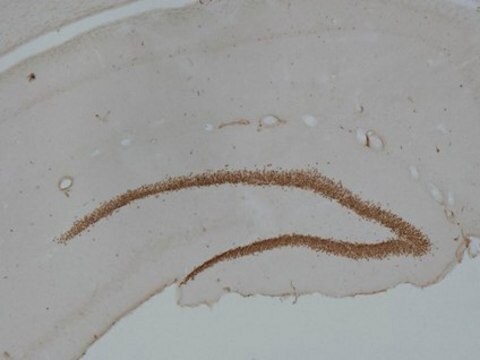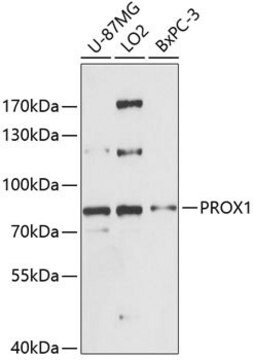AB5475
Anti-Prox 1 Antibody
serum, Chemicon®
Synonym(s):
Anti-A230003G05Rik, Anti-PROX-1
About This Item
Recommended Products
biological source
rabbit
Quality Level
antibody form
serum
antibody product type
primary antibodies
clone
polyclonal
species reactivity
rat, mouse, zebrafish
species reactivity (predicted by homology)
human
manufacturer/tradename
Chemicon®
technique(s)
immunocytochemistry: suitable
immunohistochemistry: suitable
NCBI accession no.
UniProt accession no.
shipped in
dry ice
target post-translational modification
unmodified
Gene Information
human ... PROX1(5629)
General description
Specificity
Immunogen
Application
1:2,000-1:10,000 with overnight incubation on 4% paraformaldehyde fixed, frozen tissue sections. For embryos immersion fixation is recommended. For older animals perfusion fixation is recommended. Suggested permeabilization solution is 0.1% Triton X100. Suggested blocking buffer is PBS with 0.1% Triton and 10% serum.
Immunocytochemistry:
A previous lot of this antibody was used on Immunocytochemistry
Physical form
Storage and Stability
Analysis Note
Embryonic brain tissue.
Other Notes
Legal Information
Not finding the right product?
Try our Product Selector Tool.
recommended
Storage Class Code
10 - Combustible liquids
WGK
WGK 1
Certificates of Analysis (COA)
Search for Certificates of Analysis (COA) by entering the products Lot/Batch Number. Lot and Batch Numbers can be found on a product’s label following the words ‘Lot’ or ‘Batch’.
Already Own This Product?
Find documentation for the products that you have recently purchased in the Document Library.
Our team of scientists has experience in all areas of research including Life Science, Material Science, Chemical Synthesis, Chromatography, Analytical and many others.
Contact Technical Service







